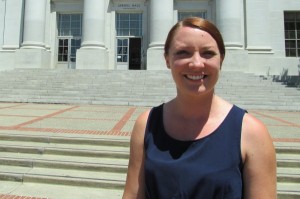Her sophomore year in high school, things got worse. During the recession, she says both of her parents lost their jobs, right after they'd bought a house in Concord.
“Then because of the housing bubble we were forced to foreclose on that home,” she says. “And so it was kind of the perfect storm of bad circumstances that hit.”
Mullen says the only way for her to go to college was to rely on federally subsidized loans with low interest rates. Now, she’s facing a doubling of those interest rates – from 3.4 percent to 6.8 percent -- on everything she borrows between now and graduation in two years.
“It’s a helpless feeling in the fact that I’ve tried to control as many circumstances as possible - my own financial stability, how I go to school, then to have these external things affect it,” she says. “It’s frustrating and it makes me unsure of the future."
The Politics of Interest Rates
Lauren Asher, president of the Institute for College Access and Success in Oakland, says it makes no sense to let subsidized loan rates double when interest rates in the economy are still very low and students are facing a tough time in the job market. She says it will only contribute to the growing problem of student debt that’s already surpassed $1 trillion.
“In 1993, less than half of all four-year college students graduated with loans," Asher said. "Right now it’s at least two-thirds, and what they’re borrowing is far greater.”
Part of the problem, Asher says, is that Congress has historically set interest rates for student loans somewhat arbitrarily. When Republicans wanted to reduce the deficit in 2006, rates went up. When Democrats took control of Congress the following year, they passed California Rep. George Miller's bill that stepped rates down over five years. That bill expired last year.
“I believe the thought was that they would’ve passed a more permanent solution in those five years of stepping down, but they failed to do that,” says Rachelle Feldman, director of financial aid at UC Berkeley. “Last year they managed to get together -- with all the pressure from student groups being very key and the election cycle being key -- and pass a one-year extension of the 3.4 percent interest rates. This year, that issue has gotten sort of lost in other federal issues before Congress.”
Schools Ramp Up Loan Education
As a response to the overall trends in student debt, Feldman says financial aid offices like hers are developing new tools to help students borrow smarter. The government only requires counseling for their first loans and after their last, nothing in between. So schools have started stepping up efforts to bridge the gap.
UC Berkeley students borrowing more than the average are now required to meet in person with financial aid officers and go over budgets and do estimates of the final cost of repaying their loans. The department is also developing a peer-mentoring program about financial literacy and debt education for its 25,000 undergraduates, since the 40-person office can’t reach them all individually.
“We don’t want students to be afraid. Education is one of the best ways to get out of a poor financial situation,” Feldman says.
Student Briana Mullen says if interest rates double, it won't stop her from graduating. It may force her to change career paths, though, from education policy to something she likes less that pays more. Not to mention the pressures on the rest of her life.
“Higher interest rates means I’m looking at longer term to pay off my loans,” she says. “And that means not buying a house and not starting a family immediately.”
Mullen says that for students like her the best hope is that Congress will pass another short-term extension to the current interest rate. So far, the two parties haven't been able to compromise on a permanent solution.
